E-paper displays are unusual in that power is only needed during a screen update. Once the display’s contents have been set, no power whatsoever is required to maintain the image. That’s pretty nifty. By making the display driver board communicate wirelessly over near-field communication (NFC) — which also provides a small amount of power — it is possible for this device to be both wireless and without any power source of its own. In a way, the technology required to do this has existed for some time, but the company Waveshare Electronics has recently made easy to use options available for sale. I ordered one of their 2.9 inch battery-less NFC displays to see how it acts.
What E-Paper Looks Like
An E-paper display is black and white, very high contrast, and doesn’t look quite like any other electronic display. It is about as readable as ink on paper, or somewhat more accurately, like LCD pixels but without any constraints on the viewing angle. With standard drive electronics, pixels are only capable of being either black or white, but image dithering to produce pictures with the appearance of greyscale works quite well.
This particular display’s screen is 2.9 inches diagonally, with a resolution of 296 x 128 pixels, but these battery-free displays come in a variety of sizes. The smallest is 2.13 inches, and the largest is a beefy 7.5 inches diagonal with a resolution of 800 x 480.
Updating via NFC
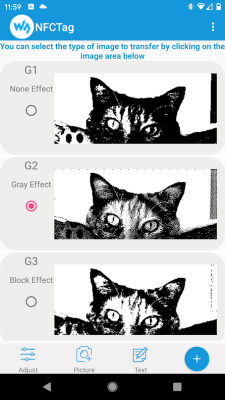 The display needs power only during a change of screen contents, and power for that comes from an NFC connection. There are evaluation kits of dedicated hardware for this purpose, but another option is a handy phone app. The app provides a simple way to send text or images to any of the Waveshare NFC displays.
The display needs power only during a change of screen contents, and power for that comes from an NFC connection. There are evaluation kits of dedicated hardware for this purpose, but another option is a handy phone app. The app provides a simple way to send text or images to any of the Waveshare NFC displays.
Handily, images can be easily cropped and dithered in a variety of ways within the app before transmission, providing a WYSIWYG (what you see is what you get) preview. There is no need to push the change to the screen in order to see how it will look, and this really helps make sure results will look good before it ever hits the screen.
When connecting, there is a definite “sweet spot” for the NFC connection to work, but it’s not hard to get used to. On my Pixel 2, the display needs to be placed right up against the back of the phone and just under the camera while the app is open, and the process begins automatically. An update takes about three seconds, during which the screen briefly goes chaotic and snowy before it updates with the new content. In general, if the connection is broken prematurely, the screen remains unchanged.
I was able to successfully update the screen by holding the phone up to either the front or the back of the display. It didn’t seem to care much which way, but the display always needed to be placed right up against the phone.
What’s it Good For?
A battery-free display is pretty nifty, but what are the intended applications? The vendor lists price tags, labels, and name badges as some of the suggested uses, so I decided to do a simple evaluation of each of those to see how well the display performed.
Text is obviously readable, so I tested both a simple barcode and a QR code. After uploading them to the display, I tested whether they could be read and decoded. Unsurprisingly, both worked flawlessly.
Testing it as a name badge took a little more work. I designed and 3D printed a holder that allowed me to mount a safety pin on the back so I could pin it to clothing like a name badge.
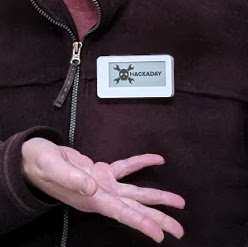
A handy feature of this display is that its enclosure has some little spring-loaded tabs on the back which can be used to clip the display into a carrier system (presumably one found on shelving units) and I took advantage of this to design a holder that was as small and light as possible while still being compatible with the spring-loaded tabs.
To attach a safety pin, I designed the simplest interface I could think of to accommodate multiple pin sizes. Two curved pieces on the back allow for a variety of safety pin sizes, and gravity does the rest. You can see more details and download the 3D models for the name badge adapter here.
The display is not particularly large or heavy, but I still wasn’t sure whether it would make a workable name badge. Thanks in part to the lightweight carrier that adds only minimal thickness, the display worked fine when pinned on and was perfectly readable, even at a distance. The badge could still be updated from the front with the phone app, but while worn in this way I could no longer update it from the back. (Recall that it needs to be touching, or nearly touching, before the NFC update will work.)
Is Batteryless a Gimmick?
As mentioned, the technology to make these displays both wireless and battery-free has been around for years, but when we first mentioned Waveshare’s offerings it was a new thing to see ready-to-use versions for sale online. It’s worth pointing out that in terms of making the display usable, the phone app is very nearly as important as the display itself. Being able to easily and conveniently update the display with little effort and no additional hardware goes a long way towards making the unit useful.
Not having a battery is remarkable, but how useful is it really from a hacker project perspective? Power needs for a display like this are so low that it’s hard to imagine battery life being much of a concern. Swapping out a coin cell once every couple years doesn’t hurt much on a single device. For an entire warehouse, that would obviously make more sense.
But when it comes to hacker projects, no battery probably makes the device somewhat lighter and smaller, but does it enable anything particularly special? It’s sure neat, but is a display like this the missing link for any particular project or concept? If any light bulbs are going off in your head, be sure to share it with us in the comments.

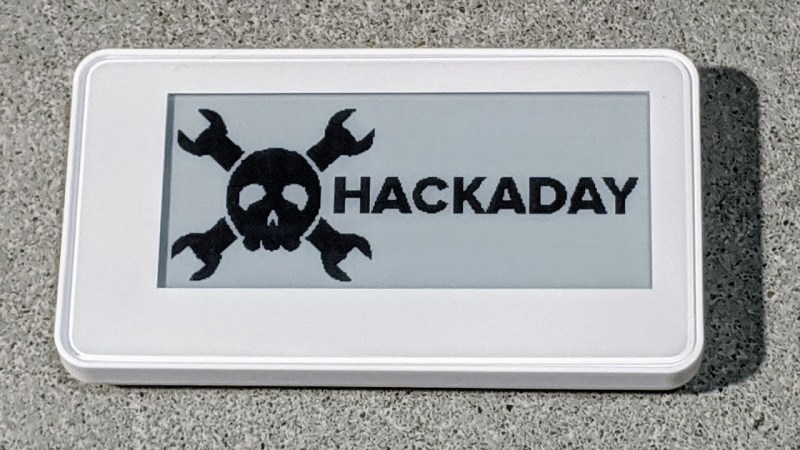
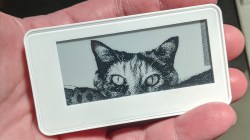
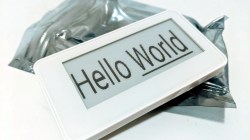
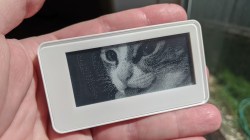
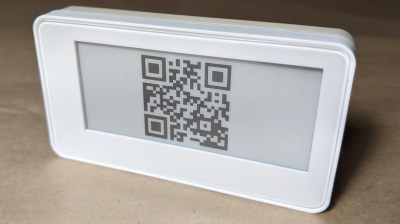
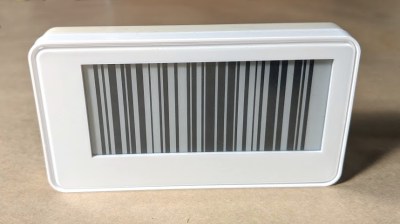














Warehouse stock management!
Exactly what I was thinking; Room cards for places like conference centers or shared office spaces (WeWork type places) are other ideas; If your organization has fallen for the myth of huge productivity gains for hot desking, these might work to show who’s where at a given time.
Conference room schedules instead of dead tree daily prints?
Also could be useful for *treasure hunt (leaderboard, checkin)*, *magic wand (hover for hint)*, theoretically lots of games could use for a temporary batteryless display, or a toggling display.
I think mezzanine layouts and cube farms are about to become cube hives with everyone walled into their own little cell.
Hot desking is a terrible thing that needs to be outlawed.
I think the store (Kohl’s) my wife works at uses these and has been for a years.
Kohls uses Altierre wireless displays which use a long life set of button cell batteries spot welded together in parallel. older displays are LCD while newer ones are e-ink in a few different sizes.
Ah thanks for the information, the displays her store uses are definitely e-ink.
First time I saw those, my hands started getting itchy. I had to hold back my temptation. I wanted to swipe one just to see what the hell was going on inside. The ones I saw were a mix of LCD and a small few were E-Ink. I just thought it was amazing how they used these displays statically and figured there was some wireless update method to flash a new image to the screen.
From a safety or compliance perspective, if you can get rid of a battery (even a coin cell) for a mass marketed product and can power it from NFC vampire power then you safe yourself a metric tonne of regulatory headaches (Speaking from experience).
Batteries and end devices can require quite a bit of paperwork, testing, certification depending upon the size and if they’re rechargeable or not.
That’s a good point. I hadn’t known batteries could be such a regulatory pain; thanks for sharing!
Might be why old fashion dry cells remained the status qua for small devices for so long.
>very high contrast
Well, about 10:1 which is high for an e-ink display but on the cheap side for ink on paper.
Is there any ‘security’ built in? Or can I just alter price tags in a supermarket?
Good question!
(I’m only commenting so I can get notified of new comments via email. I can’t find a way to get notified of new comments without first commenting, is there?)
This does seem a lot easier than my old strategy of carrying a pricing gun with me to scam stores, all I need now is an app for my phone!
They may not honor the wrong price if it gets scammed too much.
They could add some extra security on top of what NFC has by using a non standard frequency or requiring a hardware key to be inserted.
Neither if these would stop exploits just slow them by raising the bar of difficulty.
Altering the tags wouldn’t matter, they are just a visual display for your eyes, they aren’t the source of the price data. The item is still scanned by barcode and you’re charged the amount set in the store’s inventory system.
Ah yeah, but (at least in the jurisdiction I am leaving in) what counts is the price that is displayed, not the one in the database. Consumer protection and all that…
“Living” not “leaving”. Edit button please?
And some stores in my country offer double the difference if they make a mistake, i.e. the scanned price is higher than the displayed price.
I’ve got the 7.5″ version and ordered it as a curiosity, much the same as you. I tend to use it for a shopping list as I can just leave it in the basket rather than unlocking my phone each time I check the list.
There have color ones now.
https://www.eink.com/color-technology.html
E Ink Prism for architectural use sounds amazingly cool (to witness and play with, but doubt I could ever afford to do it at home like I dream)
Here’s my two cents. I always wanted e ink display on the back of my phone as I most of my reading on it. I know kindles are available but they do not easily fit in my pocket, unlike my phone which is always with me. I’d love to stick this screen to the back of my phone and when I open my reading app, I can lock the screen and the text would be on the back side of the phone and by pressing volume button it could refresh. Now, price tag, thickness and lack of programming knowledge prevents me from using it as I want to.
Check out yota phone. It’s really handy.
Intersting but the first google hit was that they went bankrupt. maybe I score a second hand one somewhere.
> In April 2019, Yota filed for bankruptcy. The bankruptcy stemmed from a lawsuit filed against the company by its contracted manufacturer Hi-P Singapore
What we need is a phone case maker to embed one of these in the back of a phone case over the NFC reader. Maybe add a couple scroll buttons. You could have it display anything including notifications and scheduled taks/appointments. A shopping list could be useful. I would most certainly buy that.
That is an excellent idea, I’m certianly right behind you in the queue.
That would be my second case I have ever bought if the screen was similar size to phone screen size.
I just realised that on the back of the phone usually there is at least one camera and sometimes also fingerprint reader so no… no similar size.
I was thinking of SDR. While a waterfall display or spectrum need to be updated regularly, there are also relatively static status indicators (AM, FM, SSB, current frequency, battery level, etc.) which could be on a secondary E-Ink display.
Price tags? Remote updateable e-paper price tags exist. Now this is a step back: expensive and needs a worker running around. For more than $20 (2.9″) / $60 (7.5″) a pop? Never.
This Waveshare stuff is insane expensive. Commercial e-paper price tags go for less than $10 a pop. Remote updates, server not included. :-) This has potential for hackers. Cheap display and remote updateable….
Look at EPDiy https://hackaday.io/project/168193-epdiy-976-e-paper-controller The ED097OC4 9,7″ Kindle Replacement e-paper goes for about $40 on the bay. 9.7″!
What happend to Inkplate 6? https://www.crowdsupply.com/e-radionica/inkplate-6
It also for the very same reasoning has a use – quick deployment while being reusable. Think your shelf labels in a store with second hand goods – never the same things twice, layouts of said stores change often to fit in the latest items etc.
For a supermarket with very static aisle layout the permenant set up makes way more sense.. For anywhere needing flexablility this cost isn’t that bad – could easily end up spending that on new labels (a label might be cheap but if you keep changing and putting up new ones won’t take long to pay for these tags.
We use 1×3″ labels for such things that run about $150 for 15k of labels, so basically 2k labels for the same $20. That would last 5.5 years if you changed the label out once a day for every day of the year.
I’m not sure it would be worth factoring in the infrastructure costs, they really are very low in both cases.
The zebra industrial label printer may have been a grand, but its 15ish years old and still going strong.
I can’t imagine an NFC setup having a higher up-front cost than that, and even this implementation would have similar human costs with both, having someone need to walk around to change the contents.
I’m not sure if a second hand store would be best served with this, but yes there are plenty of other use cases where a 5 year break even point is of no concern.
Now if they were individually addressable displays, and a UHF transmitter (More RFID than NFC) could be mounted in the ceiling and bulk update the displays for about the same cost as that zebra label printer… *that* would make the system far Far more attractive!
Wireless bulk update sounds great. Not sure if you can provide sufficient wireless power without ‘microwaving’ the whole place though. NFC because its so close can transmit power relatively efficiently. And the E-ink screens need very high voltages so the step transformer needs a pretty stable supply to generate good enough high voltage..
Inkplate 6 was delayed a little by COVID-19 but is currently shipping to backers.
This will be a fantastic and cheap display for stuff once the patents expire.
* once a “disrupt labels” startup kites to the stratosphere on VC funding then burns up and several million of them hit the surplus stores.
Shhhh!
We don’t want “them” to know we are wise to that!
I’m imagining QR codes on these storing a text message dead drop.
The display technology is all very cool, the concept of transferring the data wireless and the fact that no battery is required is awesome… but this doesn’t make it a good name tag. This cannot do anything more then a printed name tag, but in the mean time it’s a gazillion (maybe a bit less) heavier then a piece of paper. It’s not that you are constantly require your name tag to be updated when you are on an event that requires a name tag.
A shop that updates the product info each day with the latest prices may benefit from not having to print the price tags, although… swiping a phone across each display isn’t very practical either… on the other hand an shop with variable prices isn’t practical at all. Being able to update all the tags across the entire shop would be more ideal.
Regarding updating, as mentioned by others already, how is the protection? Can anybody change the content? That’s a very interesting question.
So regarding this “review” (or is it an article about somebody hacking this thing, doing something useful with it), I wonder if this item gets an sequal in the near future, a part II of the story that demonstrates how you can hack this little gadget. Considering the websites name this isn’t far fetched, is it?
Is it the best option for every situation – obviously not.
However name-tags with QR codes on for access permissions is an example that springs to mind as very useful. You want to secure your building/ keep only the ‘trained’ makers using tools in your space (damn health and safety insurances) – having a ‘permenant’ tag for each member that isn’t static will make spoofing the system much harder – that picture you took with the long lens yesterday (or mag stripe you skimmed while the card was left on an unsecured desk etc) isn’t valid anymore but without all the hassle of reissuing.
I wouldn’t worry too much about folk spoofing the displays even if there is no security, not that many juvenile arseholes in the world and its easy to set right once its spotted. Obviously better if you need authentication to get the display to change though.
So much potential in this idea, and it definitely can do much more than a printed name tag… Its just picking the right problems to apply it to.
Have been wondering how Kohls set the prices on the price tags for their shoes – now I know
Whats it good for? What about E-fitti? Put the display on a wall, put up instructions on how to update the display with your phone and let people leave their own messages on the display, E-fitti.
I can’t find anything about “E-fitti” with a quick search. Have any more details?
Think of “electronic graffiti”
But, I can see taggers spray painting over the e-ink displays, like everything else they vandalize.
Dream big like Canter and Siegel be the first electronic price tag spammer.
“Eat at Harga’s House of Ribs: Todays special Rat AM$0.04 Rat with ketchup AM$0.07”
Why not E-Fitti? Put the display on a wall with instructions on how to update the message with their phone and they can leave a message on it.
Looks like the price tags Nebraska Furniture Mart has in their stores.
Could use them for orienteering or some tricky geocaches, depending on weather and glare resistance.
I sure hope you were wearing a balaclava or ski mask in that name tag photo. Next time make sure it’s in frame so that we know you’re a hacker.
Well, the photo doesn’t show if the sweatshirt is a hoodie, along with dark sunglasses.
But, I don’t see any backpack straps in the photo…
For the name tag solution, instead of having a gazillion business cards printed, rather have a QR code with your profile and company profile that other delegates can scan and store, provided the right etiquette / protocol is followed.
Save the environment
More personal (and can be more personalised) than scanning the list of delegates from the organisers database.
Store with location and event – to jog memory after a year :)
Headhunters can ‘follow’ you, when your social media details are included……
Avoid the spread – contactless business cards – no touching and sanitizing :)
Well, back in the days of PDAs…
you could have an electronic business card (vcard?) you could IRDA to someone with another PDA.
The comic strip “User Friendly” the character “Pitr” once beamed his vcard to an entire convention floor using a high powered IR lamp.
Glad to see the responses.
We’re working with this and have made https://paperd.ink
Looks very interesting, but has anyone managed to work out the NFC commands to drive it? Would be great to drive it with an arduino and a pn532 or something, but nothing in the documents about the commands. Waveshare aren’t super helpful with email support either.
Neat device but the asymmetric screen placement is quite bizarre
Instead of a safety pin – how about using a set of magnets?
Good idea, but I wonder if the magnets interfere with the coloured E paper coloured particles?
The particles are moved using a static (electric) field. There is not magnetics involved.
We have these things (I think they might be identical) as price tags in the Mega Image supermarket chain. I think Waveshare most likely just bought these off the shelf and (maybe) made an app to update them. These have been around for ages. You can even get these for as low as a couple of dollars on Alibaba if you buy in bulk.
Not the same. The shelf displays update over Radio (RF) or infrared. Not NFC.